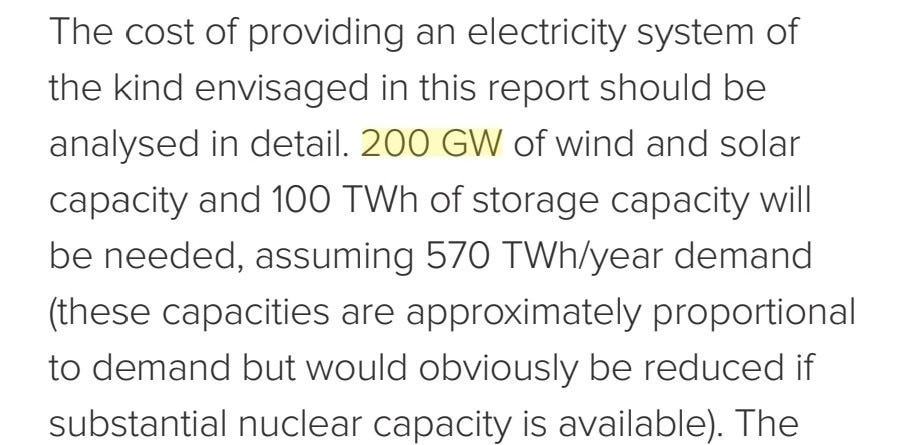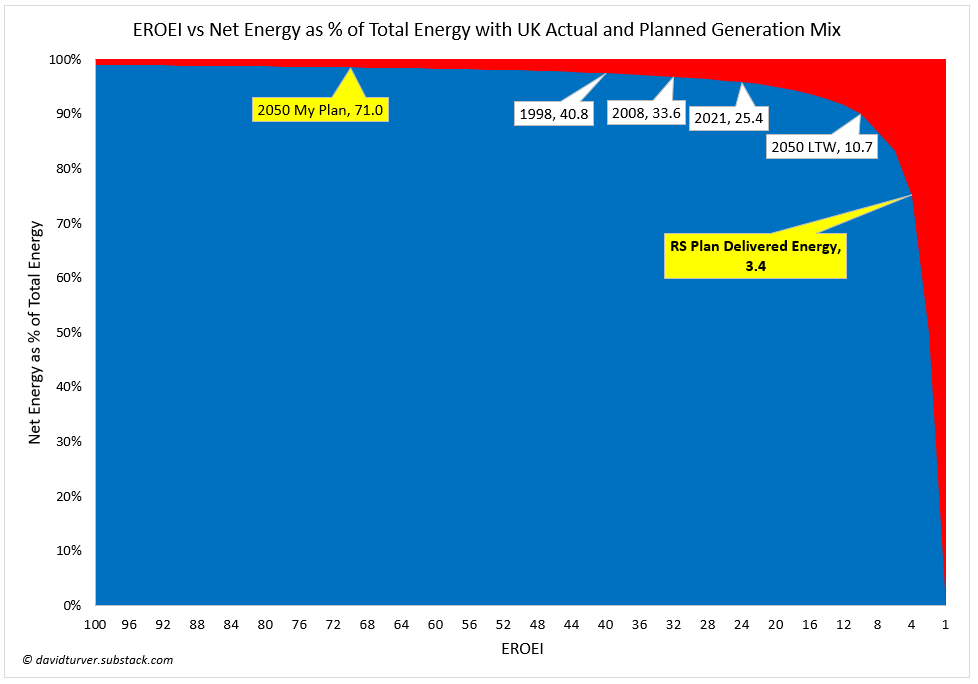More Royal Society Inconsistencies
Have they split renewables by installed capacity or delivered energy?
Introduction
Regular readers will remember last week’s article that dismantled the Royal Society (RS) report on large-scale electricity storage. In that article I pointed out the apparent inconsistency of the solar PV generation exceeding the installed capacity during July and indicated that there might be another hidden flaw in the report. Well, with the help of a correspondent on X (formerly Twitter), I think I might have got to the bottom of the discrepancy. It appears the Royal Society report is not internally consistent with itself.
The Hidden Flaw
Figure 1 (and coincidentally, their Figure 1 too) shows the theoretical electricity supply and demand profile for 2050 if the demand from 1992 was scaled up to the expected demand of 570TWh in 2050 and supply is met by 80% wind and 20% solar power.
As you can see, solar output peaks just under 80GW during many days in July and wind output peaks at just over 120GW in January. On page 81 of the report (see Figure 2), they discuss needing 200GW of installed capacity to meet the average demand of 570TWh. This supply must deliver around 741TWh on average so the excess can be used to make hydrogen that is stored then burned to cover the times when demand exceeds supply wind and solar.
Using 200GW installed capacity and the split of 80% wind (split 70% offshore and 30% onshore) and 20% solar and the capacity factors they indicate gives the required 741TWh of average supply as shown in Figure 3.
Of course, this results in only 40GW of solar capacity, so how on earth can this deliver nearly 80GW? The answer appears to be that in some places in the report they split the capacity on a delivered energy basis and not on installed capacity. Splitting the capacity in this way yields a very different result as shown in Figure 4.
Splitting by delivered energy requires a total of 297GW of installed capacity with 154GW of solar power, 60GW of onshore wind and 83GW of offshore wind. This results in a marginal reduction in the average cost. The 154GW of solar generation ought to be able to deliver 80GW sometimes in the peak month of July. However, peak supply of 125GW from 143GW of wind capacity, a load factor of over 87%, looks somewhat implausible as that means we will have almost perfect wind conditions simultaneously over the whole country and large parts of the North Sea for an extended period and none of the turbines have broken down during that period.
It is not clear which parts of the RS report are based on splitting the generation by installed capacity and which by delivered energy. All we can say is that the report is internally inconsistent therefore some parts of the analysis are erroneous.
Impact on Deliverability
Using the split by delivered energy, I re-ran my deliverability analysis as shown in Figure 5.
The solid yellow line shows the trend in installed solar capacity from 2009. The dotted yellow line extrapolates that trend out to 2050. The yellow triangle shows the target capacity by 2050 based on splitting the capacity by delivered energy. The trend line delivers around 55GW by 2050, nearly 100GW short of the 154GW target. Onshore wind is shown by the blue lines and blue square. The trend line would deliver around 42GW by 2050, some 18GW short of the 60GW target. It is probably safe to say we have no chance of delivering 154GW of solar by 2050, whereas the gap was much smaller when the split was by installed capacity. Onshore wind is also further away from the target than the earlier analysis based on installed capacity.
Offshore wind would be some 43GW short of the 83GW target. This is a smaller gap than when splitting by installed capacity, but still way out of reach.
The overall impact is to make the whole system less deliverable than splitting by installed capacity. And remember, this analysis carries forward the unrealistic wind load factors assumed by the Government and as I showed last week, the total energy requirement is well short of what we would need to run a modern economy.
Impact on System-wide EROEI
I also re-ran the analysis of system-wide energy return on energy invested (EROEI) by splitting the capacity by delivered energy instead of installed capacity as shown in Figure 6.
There is a marginal change in system-wide EROEI moving from 3.8 to 3.4, but this is in the wrong direction moving us further down the energy cliff.
Conclusions
In some ways, the RS report is worse than I first thought, because as demonstrated here, it is not internally consistent. Therefore, we do not know which parts of the RS analysis has been conducted based on installed capacity and which on the basis of delivered energy.
Moreover, reanalysis based on delivered energy makes the whole system less deliverable and even less desirable. What a mess.
If you have enjoyed this article then please share it with your family, friends and colleagues and sign up to receive more content.










When I do these analyses I always consider the range between an all solar and an all wind solution, varying e.g. the solar from 100% down to 0% in tranches of say 20% initially. This allows some insight on how the major variables influence costs for grid capacity and storage etc..and also to see whether there is a reasonably flat optimum that might allow some flexibility to handle changes in relative costs. The RS really should have presented such an analysis explicitly up front, instead of the somewhat confused discussion in the supplementary appendices.
The next stage is to examine the trade off between storage and overbuild/curtailment, and indeed to look at how the storage/curtailment requirement escalates on the path towards an all renewables grid. That would reveal that costs will start escalating alarmingly once we go beyond about 60% of energy supplied by renewables. I have provided analysis of that to OFGEM and BEIS and the BEIS Select Committee that appears so far to have been studiously ignored.
Of course, they also failed to consider the cost landscape adequately, and the real world performance of wind turbines. I am thinking of writing to Iain Staffell and asking whether there are plans to make available the RS wind and solar datasets at his renewables.ninja website, as has been done for some other papers that relied on his weather reanalysis tools. Then we can get a much better handle on the extent of rosiness in the workings.
Another Net Zero bill. According to the IEA there is a need to install 80 million km of transmission lines
https://www.energylivenews.com/2023/10/17/nearly-80-million-kilometres-of-grids-needed-by-2040-to-meet-climate-targets/
at say £1.25m/km that's a mere £100 trillion bill for the world to pay. There may be an awful lot of coffee in Brazil, but is there enough copper in Chile?